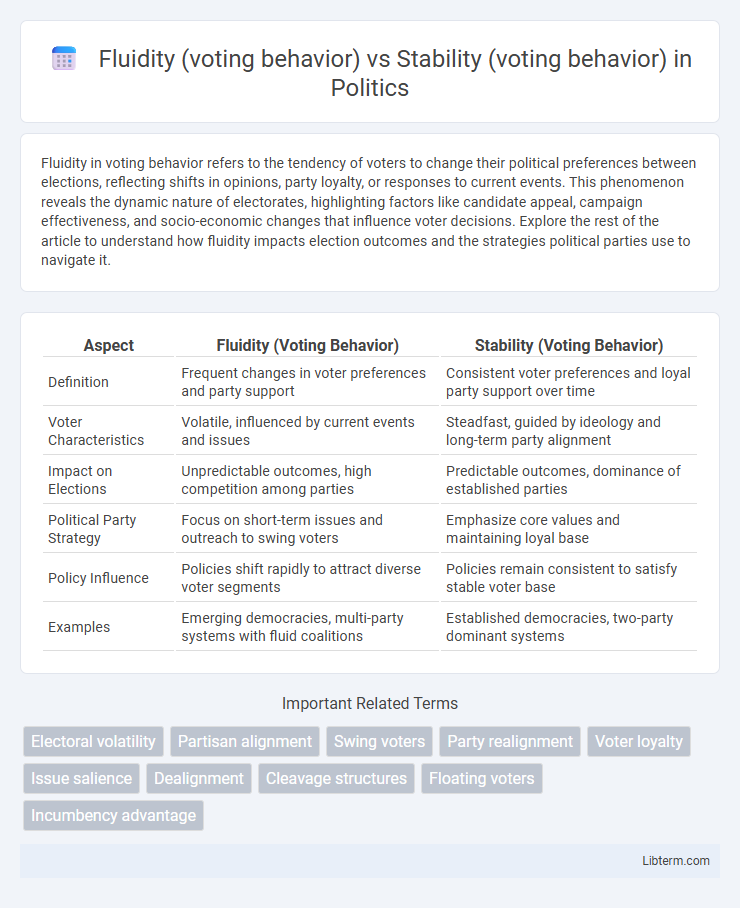Fluidity in voting behavior refers to the tendency of voters to change their political preferences between elections, reflecting shifts in opinions, party loyalty, or responses to current events. This phenomenon reveals the dynamic nature of electorates, highlighting factors like candidate appeal, campaign effectiveness, and socio-economic changes that influence voter decisions. Explore the rest of the article to understand how fluidity impacts election outcomes and the strategies political parties use to navigate it.
Table of Comparison
| Aspect | Fluidity (Voting Behavior) | Stability (Voting Behavior) |
|---|---|---|
| Definition | Frequent changes in voter preferences and party support | Consistent voter preferences and loyal party support over time |
| Voter Characteristics | Volatile, influenced by current events and issues | Steadfast, guided by ideology and long-term party alignment |
| Impact on Elections | Unpredictable outcomes, high competition among parties | Predictable outcomes, dominance of established parties |
| Political Party Strategy | Focus on short-term issues and outreach to swing voters | Emphasize core values and maintaining loyal base |
| Policy Influence | Policies shift rapidly to attract diverse voter segments | Policies remain consistent to satisfy stable voter base |
| Examples | Emerging democracies, multi-party systems with fluid coalitions | Established democracies, two-party dominant systems |
Understanding Fluidity in Voting Behavior
Fluidity in voting behavior refers to the tendency of voters to change their political preferences between elections, reflecting shifting attitudes influenced by current issues, candidate appeal, and social dynamics. This contrasts with stability, where voter allegiance remains consistent over time, often due to strong party identification or ideological commitment. Understanding fluidity is crucial for predicting electoral outcomes and designing effective campaign strategies, as it highlights the volatility and responsiveness of the electorate.
Defining Stability in Voting Patterns
Stability in voting patterns refers to the consistent support of specific parties or candidates over multiple election cycles, reflecting entrenched political preferences within an electorate. It is measured by the low volatility or minimal shifts in voter alignment, often indicating strong party loyalty or satisfaction with governance. Analyzing stability helps predict electoral outcomes and assess the resilience of political systems amid social and economic changes.
Key Factors Influencing Fluid Voting Behavior
Key factors influencing fluid voting behavior include shifting political attitudes, changing socioeconomic conditions, and exposure to diverse media sources, which lead voters to frequently reevaluate their preferences. In contrast, stability in voting behavior is often driven by deeply ingrained party loyalty, consistent ideological alignment, and strong identification with demographic groups. Understanding the role of evolving issue salience and voter information processing helps explain why some electorates exhibit fluidity while others maintain stability.
Determinants of Stable Electoral Choices
Stable electoral choices are primarily determined by deep-rooted social identities, such as class, religion, and ethnicity, which create consistent party affiliations over time. Psychological factors like party identification and issue importance reinforce voter loyalty, reducing fluidity in electoral behavior. Institutional elements, including electoral systems and party organization strength, further contribute to the persistence of stable voting patterns across election cycles.
The Role of Political Campaigns in Shaping Fluidity
Political campaigns significantly influence voting fluidity by targeting undecided voters with tailored messaging and strategic outreach, increasing voters' susceptibility to change their preferences. Effective campaigns employ data analytics and media personalization to amplify candidate appeal and reshape voter perceptions, thereby enhancing fluidity in electoral behavior. This dynamic contrasts with voting stability, where entrenched partisanship and strong ideological commitments limit the impact of campaign efforts on voter decisions.
Impact of Socioeconomic Factors on Voting Stability
Socioeconomic factors significantly impact voting stability by shaping individuals' political preferences and level of electoral participation. Higher income, education, and occupational status often correlate with more stable voting behavior due to stronger political engagement and vested interests in policy outcomes. Conversely, lower socioeconomic status can lead to greater fluidity in voting as economic uncertainty and changing social circumstances drive voters to shift allegiances between elections.
Historical Shifts: Case Studies of Electoral Fluidity
Historical electoral fluidity reveals significant shifts in voting behavior, as seen in the United States during the realignment of the 1960s when Southern voters transitioned from the Democratic to the Republican Party. Similarly, the United Kingdom experienced notable fluidity in the 2010s, with traditional Labour and Conservative loyalties challenged by the emergence of the Brexit Party and increased support for smaller parties. These case studies underscore how political, social, and economic factors drive voter realignment, contrasting with periods of stability characterized by consistent party allegiance over multiple election cycles.
Advantages and Disadvantages of Voting Behavior Fluidity
Voting behavior fluidity allows for adaptive political choices reflecting current social and economic conditions, enhancing democratic responsiveness and innovation in governance. However, excessive fluidity can lead to political instability, unpredictability in policy-making, and weakened party systems, undermining cohesive long-term strategies. Balancing fluidity with stability ensures voter representation remains dynamic without sacrificing continuity and effective government functioning.
The Importance of Stability for Democratic Processes
Stability in voting behavior ensures consistent policy implementation and fosters public trust in democratic institutions, reducing volatility that can lead to political uncertainty. Fluidity, while allowing adaptability to changing public opinions, risks undermining the predictability essential for effective governance and long-term planning. Prioritizing stability helps maintain democratic legitimacy by promoting coherent electoral outcomes and safeguarding the continuity of governance structures.
Future Trends: Will Voting Behavior Become More Fluid or Stable?
Voting behavior is expected to become more fluid as digital platforms and social media amplify diverse perspectives and rapidly shift public opinion. Emerging trends such as increased political polarization and real-time information flow contribute to volatility in voter preferences and issue salience. However, entrenched party loyalty and demographic factors continue to anchor stability, suggesting a complex interplay rather than a unilateral shift.
Fluidity (voting behavior) Infographic

 libterm.com
libterm.com